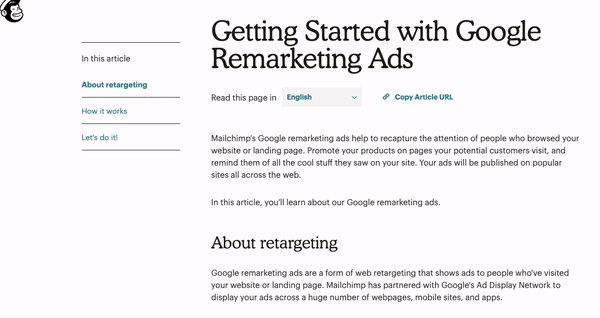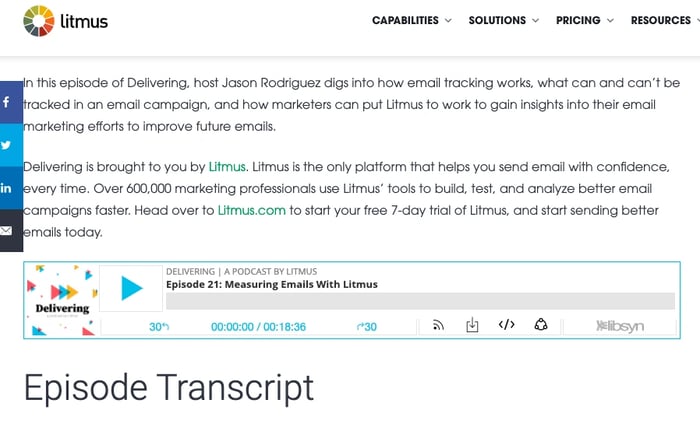Let's talk about content.

More specifically, long-form content.
Not only that, but why it's a good idea to have on your website.
Let's say you're looking for a resource about how to start an online business. You want a full rundown, concrete information, and actionable tips that will assist you begin a successful company. You're probably going to want a lengthy resource that's valuable, right?
This is the glory of long-form writing. It gives you a chance to provide highly motivated readers with a ton of value and context. Long-form content generally has a word count of more than 1,000 words — so, it’s not the shortest read.
That doesn't mean that short-form content isn't useful for your website. You should have both to serve different purposes. Let's take a minute to look at how.
Long-Form Content
On the surface, long-form content doesn't sound like it's great for user engagement. It might seem counterintuitive to give your audience more to read in order to keep them on your website longer. But it's true, and I'm going to dive into why below.
I'm here, however, to debunk that myth. Let's add a definition to the term, first.
What is long-form content?
Long-form content describes a piece of writing that is between 1,000 — 7,500 words. You might want to read long-form content to get a deep dive of complicated subjects from a robust source of writing.
The purpose of long-form content is to provide valuable information to the reader. If you write long-form pieces — and make sure those articles and essays are useful to your audience — you can increase the time spent on your site and value to your reader.
More than that, if you optimize your website for search engines and add calls-to-action in the body of your piece, you can improve lead generation. Your articles will have a higher chance of showing up on the first page of SERPs, and you can guide readers to offers that relate to the topic of your work. Similarly, for essays and academic writing, you should structure your content to make it easier for the reader to understand your question, argument, and analysis. With the growth of AI essay writers, content writers, and blog writers, making engaging and optimized content is becoming even easier.
Sounds pretty great, right?
But wait — if there's content that's long-form, there has to be a short version, right? It's important to know the difference between the two so you know how to best serve your audience.
Long-form content vs. short-form content
Short-form content can be extremely helpful to readers who want a quick answer to their queries. For instance, you can offer short-form content to provide a simple definition or explain a product in small portions. Short-form content gives your reader the information fast so their attention doesn't wane.
This type of shorter writing is generally under 1,000 words. It provides a general overview and saves readers time. Long-form content, on the other hand, goes deeper into topics.
In addition to diving deeper into topics, long-form content can aid with ranking highly on search engines and build your website's reputation.
For example, this article, about how to write a blog post, has earned thousands of views. Additionally, the average time spent on the page is about four minutes. From these metrics, we can guess that this 17-minute read, well over 1,000 words, was successful in providing value to the reader.
This doesn't mean that you should fill your blog with 17-minute reads. But it can be useful to start thinking of how long-form content can be effective for your audience. How can you provide ample writing that's actionable for readers?
If you build an archive of long-form content that's valuable for readers, you can create a reputation as a source people look to first to help them solve their questions. It's kind of like ordering a product online. You're probably more likely to order from a site you've used many times before, that has proved to be reputable, instead of trying out a brand new ecommerce option.
Let's look at another reason why long-form, valuable writing is successful: page rank on Google. Backlinko found that websites with a high "time on site" are more likely to rank highly on search engine results pages (SERPs).
When a search query is typed into Google, the search engine crawls websites for content that will help solve that user's query. Web pages that have a longer time spent on site than others suggest to Google that browsers found that information important enough to stay on that page.
As a result, Google is more likely to suggest that page above others. (Don't forget that a page optimized for SEO is also a huge boost to improving rank).
So now you know why long-form content is important to have on your site: It provides values to readers, can earn you a reputable reputation, and brings more eyes to your site. But what does successful long-form content look like? Let's take a look at some examples.
Long-Form Content Examples
Before we talk about how to write long-form content, let's look at some effective examples. These examples show how long-form content can be optimized for the reader's comprehension.
1. Hayley Williams Isn't Afraid Anymore by Rolling Stone
This long-form profile about solo artist Hayley Wiliams, written by Brittany Spanos for Rolling Stone, does a great job of performing other content produced by Rolling Stone about the same topic, or those that are similar.
Within the profile, other works previously done by Williams or her rock band, Paramore, are featured and hyperlinked to previous RS articles that are applicable. For instance, the word "Paramore" was hyperlinked to an internal tag of the same name, showing all previous RS posts that mentioned the band.
A particularly intriguing mention of past works related to the topic, Williams, comes up in the sidebar of the feature. There, you can find previous music reviews of the singer/songwriter's releases. This is a visual way to promote past content, and one that catches the attention of readers.

If you want to include other works in your long-form content that relate to the article, consider an approach similar to this one. You'll give the reader a break from reading the piece to queue up similar posts for later. Additionally, you'll provide more value to the article by offering up supporting ideas.
2. Getting Started with Google Remarketing Ads by Mailchimp
Mailchimp is a marketing software platform. This post is a guide to navigating setting up Google Remarketing Ads. Complete guides about a topic that pertains to your industry are a wonderful example of a long-form content piece that you can add to your blog.
What's great about this article is that it shows off a table of contents, different languages to read in, and social sharing options.

Adding in a table of contents helps the reader easily navigate through a longer piece if they are only interested in one section. And international readers are able to read in their native language with the opportunity to translate the text.
3. Delivering Emails with Litmus by Litmus
This long-form content is a transcription of a podcast episode that was embedded into the post. I get it: Even with software available, it's taxing work to do a transcription. Even this short, 18-minute episode was not an easy feat to transpose.

However, if you create YouTube videos or podcasts, a transcription can make your audio/video content accessible to audience members who are hearing impaired.
If for some reason, the embed of the audio file doesn't work or a quote doesn't come through clearly, the non-hearing impaired listeners can identify what was said without having to mentally fill in the blanks. I would find a transcription helpful if I were writing an article and wanted to pull a quote, or if I wanted directions on how to use software and didn't want to keep rewinding.
4. 77 Essential Social Media Marketing Statistics for 2020 by HubSpot
Data is great material for a long-form post, like this one from HubSpot. This post is classified as a long read, but because the statistics included are short and formatted in a comprehensible way, readers are able to get through the post easily.

When you section off stats, for instance, "General Social Media Marketing Statistics," and "Facebook Statistics," you make it easier for readers to jump to the section they're looking for. Additionally, the words are sectioned off for organization.
Now that you've seen some examples, you're probably stoked to get started writing your long-form content. Before you do, take a look at the tips below to make sure your work is actionable, comprehensive, and accessible.
How to Write Long-Form Content
Outside of concrete grammar rules, like subjects and predicates, there's no "right" or "wrong" way to write. That said, there are ways to create content that's digestible and useful to readers. I'm going to be referencing using HubSpot, but feel free to use similar software to format your post.
Writing Long-Form Content
- Form your paragraphs in comprehensible sections.
- Section off your main ideas.
- Make sure your thoughts are organized.
- Describe the 'so what?' of each section.
- Keep a conversational tone throughout your piece.
- Hook the reader with an engaging introduction.
- Add visuals to break up long sections of text.
1. Form your paragraphs in comprehensible sections.
When you sit down to write your long-form piece, take note of paragraph structure. To optimize your piece for readability, keep paragraphs short. Ideally, paragraphs shouldn't be longer than three sentences, unless it makes sense to add more.
Let's talk about that exception. If you're writing a paragraph where the impact is best presented in rhetorical questions, for example, it might look better to keep those questions in the same section.
Does the paragraph have an effect on the reader? Do you effectively get your point across? How will you use paragraphs to make content digestible? Are you pulling the reader in with your formatting?
In some cases, it’s alright to ignore the three-sentence rule if, like above, each sentence flows together. Adding an entire new paragraph just to fit that extra question doesn't provide the same effect and does little for formatting.
2. Section off your main ideas.
Headers are your friends. H2s, H3s, and H4s can be found in almost every writing tool, such as Docs, Word, WordPress, HubSpot, and other software programs. Headers help you guide the reader through the main ideas of your piece by breaking off your content into sections.
For instance, in this piece, the main idea of this section is "How to Write Long-form Content," so I made it the H2, which is generally used for titles and main ideas. The list items underneath this section are formatted into H3s, which support that main idea. If I were to add subsections underneath any of these list items, they would be H4s.
Headers split up long sections of your text and assist with organization. If this piece lacked these items, it would be pretty difficult to navigate. Additionally, when I'm outlining a long-form post, planning headers in advance supports me in writing effective content — I can visualize what I need to add to make each portion effective.
3. Make sure your thoughts are organized.
It's crucial for long-form content to make sense. So, before you press "publish," read over your piece for organization. Ask yourself if your piece has a beginning, middle, and ending that readers can follow.
Your sections should have a logical format. For example, in this piece, I wouldn't have jumped into providing steps to writing long-form content without first explaining the definition. Think about if Cinderella started with the royal wedding, then circled back to Cinderella cleaning the house — that wouldn't make much sense.
Readers could get confused if your work isn't organized in a logical way, so be mindful of formatting.
4. Describe the 'so what?' of each section.
Long-form content has an added difficulty of keeping readers engaged throughout the piece. To combat this, make every paragraph count. This will do two things: Avoid unnecessary added length, and keep readers compelled.
When you write a longer piece, you don't need to add extra information that doesn't serve the purpose of the post. This can lead to convoluted, intricate paragraphs or sections that don't make much sense.
To keep readers interested, get to the point. End sections with why the readers should care. This ensures they get the most out of your article.
5. Keep a conversational tone throughout your piece.
This tip circles back to keeping the attention of viewers. Instead of taking an extremely formal tone, it's okay to lighten up a little. In college, whenever I read academic textbooks, it was hard to keep my focus. The highly technical language couldn't keep my interest.
Unless your article is an academic journal, you don't have to use complicated language to seem like an expert on your topic. If you give well, researched, thoughtful, and actionable content, readers will find your post useful. Trying to sound "too" formal could actually have the negative effect and leave your readers feeling like they don't have any takeaways.
6. Hook the reader with an engaging introduction.
Depending on the platform you use to post your long-form article, the estimated read time is given to the reader. For instance, on the HubSpot Blog, when you click on an article, you can see the read time underneath the title.
Some people might see that read time and immediately feel compelled to skim, especially if it's something like 18 minutes. To hook the reader, make your introduction something that grabs their attention.
One of my colleagues is great at this — he will present an anecdote in the beginning of the piece and continues to use that anecdote to illustrate points throughout the rest of the article. It leads to gripping posts I’m sad to finish.
If you can't think of a story or life experience to use to pull the reader in, give a relevant statistic in the above-the-fold information. What you present above the fold is what's going to make that reader think, "Oh, I have to keep going!"
7. Add visuals to break up long sections of text.
In addition to breaking up long sections with short paragraphs and headers, eye-catching visuals are another way to break up long sections and keep the reader engaged. Personally, if I'm skimming an article and see a picture or graph included, I'm immediately drawn back into the piece.
You don't always have to use images or videos. Blockquotes and anchor text are also amazing tools. Blockquotes are those huge quotes you see highlighted in articles, and anchor text directs your reader back to sections you reference earlier in the piece.
Generally, you can find these tools within the software you're using. In HubSpot, blockquotes can be added by going to the header tab, and anchor text can be found by opening the "Insert" category.
Remember to have fun with your long-form content. Writing is a creative process, and readers can tell when something was a drag to write (It's probably a drag to read).
Long-form writing has its own advantages over short-form content, even though the latter might be the quickest way to beef up your archive. It's so valuable to have longer pieces on your site, and readers will definitely find them useful.




![7 Pieces of Content Your Audience Really Wants to See [New Data]](https://blog.hubspot.com/hubfs/most%20popular%20types%20of%20content.jpg)
![How to Write a Listicle [+ Examples and Ideas]](https://blog.hubspot.com/hubfs/listicle-1.jpg)

![What Is a White Paper? [FAQs]](https://blog.hubspot.com/hubfs/business%20whitepaper.jpg)



